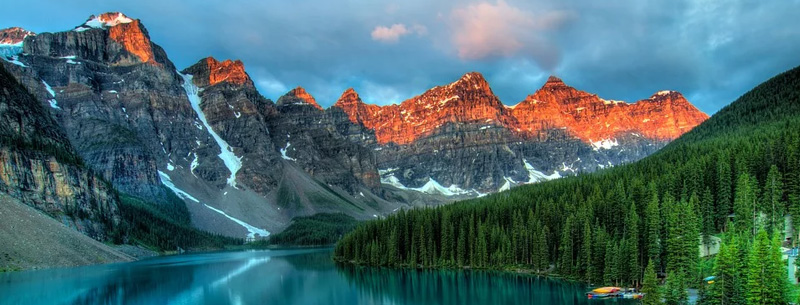2024 Alberta Visitors Guide
Alberta’s grandeur and beauty are obvious from the moment of arrival. Rolling foothills, intimidating mountains, and prehistoric hoodoos are a few of Alberta’s more distinct natural landmarks. Most impressive are Alberta’s Rocky Mountains, which facilitate the world-famous resort towns of Banff, Jasper, Canmore, Kananaskis, Lake Louise, and Waterton. Dinosaur hunters flock to Drumheller, home of the acclaimed Royal Tyrrell Museum of Palaeontology, where the desert topography yields countless fossils and prehistoric discoveries. Alberta’s rural heritage can be further explored with a visit to the vast farmlands of Alberta’s Heartland, Southern Alberta, and Northern Alberta. Calgary, home of the globally recognized Calgary Stampede, is best known for its warm hospitality, oil and gas industry and close proximity to the Rockies. Edmonton, the provincial capital, is often synonymous with its largest attraction—West Edmonton Mall. North America’s largest shopping and entertainment complex offers over 800 stores and services and over 110 dining establishments, the epitome of one-stop shopping.
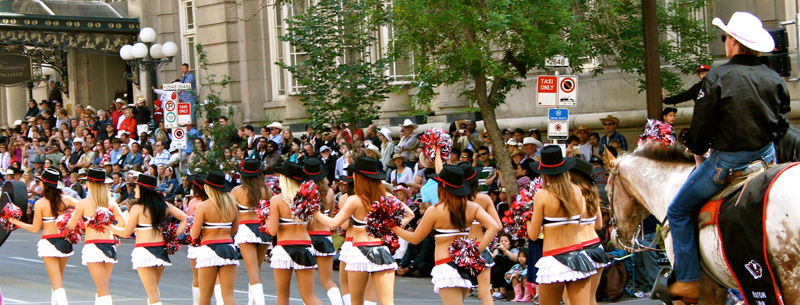
Calgary Visitors Guide
Calgary is an attractive and dynamic city situated on the banks of the Bow River and close to Alberta’s majestic Rocky Mountains. The Calgary Stampede is undoubtedly Calgary’s best-known visitor attraction. This event, featuring a large parade and world-class rodeo, draws more than a million people each year. The host city of the 1988 Winter Olympic Games takes pride in its sporting legacy. Canada Olympic Park is a multi-purpose athletic facility designed for skiing, snowboarding, bobsleigh, and luge during the winter and mountain biking during the summer. The Scotiabank Saddledome is the home of the NHL’s Calgary Flames, as well as being the venue for countless events and concerts throughout the year. Other attractions, including the Glenbow Museum, Calgary Tower and Eau Claire Market are other great places to visit year-round. Read more about Calgary >>
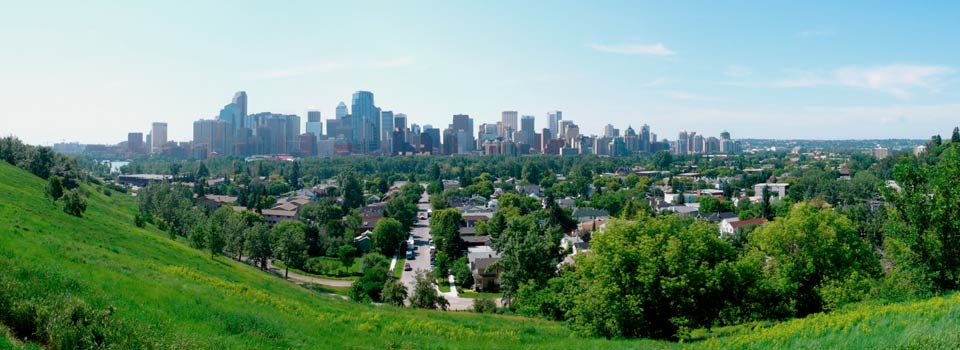
Calgary Stampede Events
Each year, millions of visitors from around the world come to Calgary, Alberta, Canada to partake in the annual event, the Calgary Stampede and Exhibition. As Calgary’s most popular tourist attraction, ‘the greatest outdoor show on earth’ features a real rodeo, a midway (amusement park), concerts, chuckwagon races and more. The city of Calgary is transformed for 10 days into town celebrating the cowboy culture. Visitors will enjoy the atmosphere and always friendly attitude of the locals.
Glenbow Museum
Located in the heart of downtown Calgary – visitors experience Glenbow Museum’s diverse exhibits, special programs and vast collections including Asian, Contemporary, Modernist and Historical Art. Mon Closed (September – June); Tues to Sat 9 am – 5 pm; Sun noon – 5 pm. Adult $14, Seniors $10, Students $9, Family $32; Members and under 6, free. Glenbow Shop opens Mon to Sat 11 am – 6 pm; Sun noon – 5:30 pm. Address: 130 – 9 Ave SE | Calgary, AB | T2G 0P3. Telephone: 1 403 268-410
Heritage Park Historic Village
Discover “How the West was Once” at Canada’s largest living history museum.
Leighton Art Centre
The Centre is a public art gallery, museum, and shop located just outside Calgary, overlooking the Alberta Foothills and the Rocky Mountains. It is open to the public year-round and offers a wide range of art exhibitions, museum displays, programming, art sales, and special events. A not-for-profit organization, it strives to promote the artistic community and to sustain a setting for art and the creative process. [Mail only address: Box 9, Site 31, Comp. #9., RR 8, Calgary, AB T2J 2T9] Tues to Sun 10 am – 4 pm.
Address: Range Road 23 – 16 km south of Calgary | Millarville, AB | T0L 1K0. Telephone: 1 403 931-3633
Edmonton Visitors Guide
Edmonton is the capital city of Alberta and is well known for its scenic river valley and a thriving music and art community. Located 294 km (183 mi) north of Calgary, Edmonton is home to North America’s largest shopping and entertainment complex, West Edmonton Mall. More than just a shopping center, West Edmonton Mall also has a giant water park, a man-made lake, a skating rink, two mini-golf courses, 21 movie theatres, a Vegas-style casino and an amusement park with 25 rides and attractions. Edmonton’s vibrant population tends to hang out and let loose at the trendy Whyte Avenue district, which is situated next to the reputable University of Alberta. The Muttart Conservatory, an expansive horticultural spectacle, is noted for its unique architecture, as is the remarkable Alberta Legislature Building. Fort Edmonton Park is a large living history museum that recognizes Edmonton’s past through a series of interactive restorations. Celebrate the summer at Edmonton’s K-Days, an exciting festival held annually in July. To take it all in, visitors will need to stay awhile, and there are plenty of Edmonton Hotels to choose from, along with many other lodging options. Read More >>
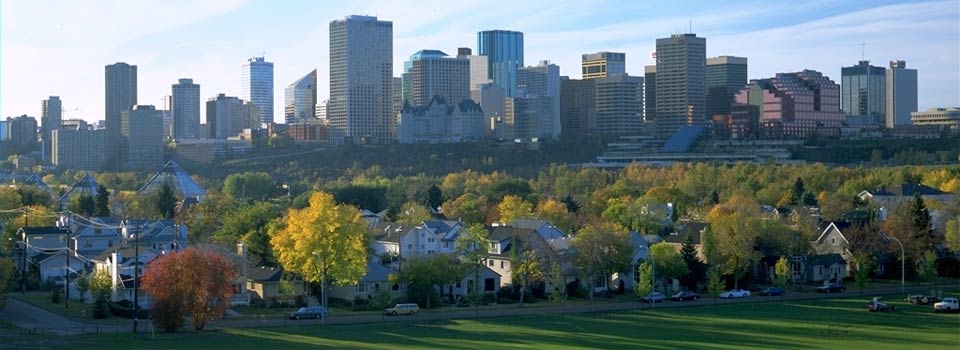
Alberta Rocky Mountains
The Alberta Rocky Mountain area is one of the most beautiful places on earth. Starting with Jasper, Hinton, Grande Cache and the Icefields Parkway in the north; Banff, Lake Louise, Kananaskis Country and Canmore in the south; and Waterton, a picturesque mountain park on the U.S border, there are a wealth of travel experiences to be enjoyed in Canada’s largest mountain range. The attractions in this region are geared towards the outdoors, taking full advantage of the natural geography of the area. Downhill and alpine skiing, snowmobiling, rock climbing, spelunking, hiking and wilderness camping are just a few of the many recreational opportunities available to visitors of Alberta’s Rockies. The small, mountain towns that are speckled throughout also add to the experience, with their small gift shops, local restaurants, and friendly disposition all making any visit memorable.
Banff
Set in the heart of Banff National Park and snugly embraced by Alberta’s Rocky Mountains, the little town of Banff boasts a big, worldwide reputation. Its charming streets are abuzz year-round due to an annual influx of millions of visitors, and this famous mountain resort town caters accordingly with world-class shopping, dining and an array of accommodation, from cabins and campgrounds to bed and breakfasts and Banff hotels and motels. At first sight, it’s apparent why the world is in love with Banff. From the ever-watchful Cascade Mountain to the picturesque Bow River, the community is blessed with a spectacular natural setting, woven with parks, woods, and trails. Winter turns the area into a snow sports enthusiast’s dream; the Sunshine Village Ski Resort and Norquay attract a global deluge of skiers and snowboarders, while cross-country skiers, snowshoers and ice climbers explore numerous local trails. Banff is an ideal base for hiking and wildlife viewing excursions into surrounding park areas during summer and provides a popular weekend retreat with excellent restaurants, golf courses, day spas, and the Banff Upper Hot Springs.
Located only 144 km (90 mi) from Calgary and close to Kananaskis Country, Canmore and Lake Louise, Banff is a convenient and much-loved mountain paradise.
Banff Mountains
Sulphur Mountain is located about five minutes from the town of Banff and offers panoramic views of the town and its surrounding area. The mountain’s summit is easily accessible by the Banff Gondola while those wishing to hike may follow a trail to the top. The starting point of the Sulphur Mountain hike trail, as marked by the map, is found at the Upper Hot Springs parking lot. Apart from an observation area, the mountain’s summit is equipped with a restaurant and gift shop.
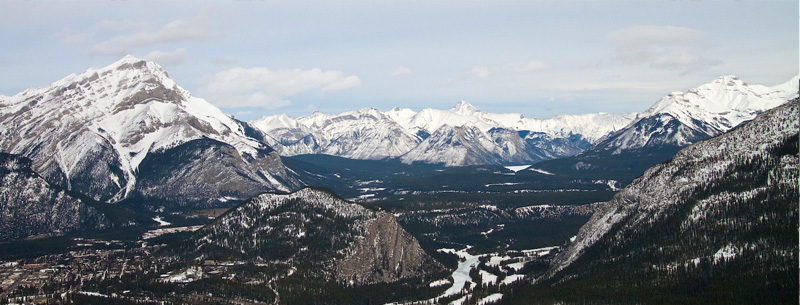
Although a modest 2,949 m (9675 ft) tall, Mount Rundle is one of the more photographed mountains in Banff because of its idyllic location, the peak often being reflected in the waters of the Vermillion Lakes. A characteristic feature of Mount Rundle is the series of long corrugated layers that appear on the mountain’s face. The peak was named for this geological pattern, which is known as the Rundle Formation.
Stoney Squaw Mountain offers a 2.1 km (1.3 mi) long trail for visitors looking to hike near the town of Banff. The trail, as marked by the map, begins at the Mount Norquay ski area parking lot. Neighbored by Mount Norquay, this mountain is characterized by its curved shape.
Popular for skiing, Mount Norquay is considered one of Banff’s premier ski and snowboard destinations. The mountain primarily offers intermediate-level skiing with a few slopes ideal for beginners. The mountain is also home to the Ski Norquay resort.
Famously associated with the town of Banff, Cascade Mountain is the looming gray peak that overlooks this community. The mountain was named in 1858 for the cascading waterfall that is located on the southern face. Among climbers, this 2,997 m (9,832 ft) tall peak is ideal for moderate level scrambling.
With its relatively easy hike to the top, Tunnel Mountain is a popular climb for visitors wanting a bird’s eye view of the Bow River Valley as well as the surrounding mountain ranges. This 1,690 m (5,544 ft) tall peak takes about an hour to hike and leads hikers through natural alpine forest. The trail, as marked by map, begins on the north side of St. Julien Road. The name Tunnel Mountain comes from an 1883 proposal, which was not realized, to create a tunnel through the mountain for the CPR railway.
Mount Louis is found in the Forty Mile Creek Valley just east of Banff. A challenging mountain for climbers, this peak juts straight towards the sky and stands 2,682 m (8,800 ft) tall. This limestone mountain was formed vertically and features dangerously steep cliffs.
Bragg Creek
On the edge of Kananaskis Country, situated amidst the foothills of the Rocky Mountains, sits the quaint and largely rural community of Bragg Creek. This beguiling hamlet is located only 44 km (27 mi) from Calgary along scenic Highway 8 and attracts many visitors, who come for the vibrant arts community, unique shopping opportunities, freshly baked pies, and gorgeous scenery. Many choose to pack a picnic and head to nearby Elbow Falls, where the Elbow River collides with the rocky slopes of the mountains to form an amazing natural spectacle. Hiking and cross country skiing trails permeate Bragg Creek’s woods and hills, inviting adventurers to an encounter with nature. Famous Allen Bill Pond is a prime location for fishing in the summer and skating in the winter. Thrill-seekers can try off-roading at the McLean Creek Provincial Recreation Area, while those who prefer a more leisurely pace can explore the lush landscape on horseback.
Elbow Falls Provincial Recreation Area
Several hundred visitors every year watch was the crisp waters of the mighty Elbow River collide with the craggy rock faces of the mountains in a spectacular natural show.
Canmore
Canmore is a gateway to the Alberta Rockies and the mountain parks. Traveling from Calgary, this vibrant mountain village is only a few minutes short of the national park toll booths, but it is far from being a coffee shop on the way to Banff. In many respects, Canmore is the Banff of 20 years ago. Not yet overwhelmed by high-end boutiques, Canmore retains a quaint low-key character where locals still form the better part of a cafe’s clientele. The streets are packed with homegrown bakeries, bookshops, galleries and sporting shops. Year-round the stores are kept busy by the added influx of skiers, hikers, and bikers looking eagerly into the surrounding mountains.
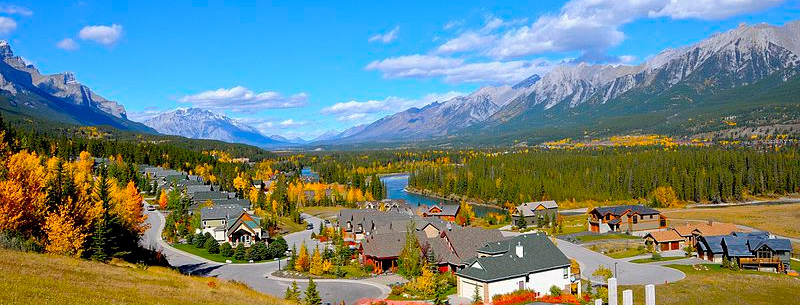
The soaring peaks, clear lakes and deep forests of the region attract campers by the hundred in summer. In winter, visitors are more likely to spend their night in a cozy chalet than outside, but the outdoors remain the central attraction. The Canmore Nordic Centre for one has miles of groomed cross-country ski trails on the town’s doorstep.
Canmore Museum & Geoscience Centre
The Canmore Museum and Geoscience Centre delve deep into Canmore’s past, including its rich railway and coal mining history.
Drumheller
Located 130 km (81 mi) northeast of Calgary in Alberta’s Badlands, the Drumheller Valley is best known for its diverse and unique topography. Made up of mostly barren terrain that includes grasslands, hoodoos, canyons and coulees, the area provides a vast landscape that is worthy of discovery, perhaps from the gaping jaw of the world’s largest dinosaur statue in downtown Drumheller, which visitors are encouraged to climb into. Drumheller is best known as the home of the Royal Tyrrell Museum of Palaeontology, a world-class facility dedicated to the study of Drumheller’s early residents, the dinosaurs. Visitors to the museum can explore hundreds of preserved fossils and take part in interactive displays and exhibits. Golfers can enjoy a challenging day on the links with the rugged terrain and wind conditions acting as natural hazards. Other outdoor activities include hiking, skiing and taking a ride on the historic Bleriot Ferry, which crosses the powerful Red Deer River.
Royal Tyrrell Museum
Named after Joseph Burr Tyrrell who discovered the first dinosaur fossils in the Drumheller Valley, the Royal Tyrrell Museum contains a wealth of information on Alberta’s rich fossil heritage.
Hinton
Hinton is the gateway to Jasper National Park in the Alberta Rockies and is located approximately 280 km (174 mi) west of Edmonton. As well as being a service and supply town for the mountain resorts, Hinton has developed its own tourism industry and is known for offering access to a multitude of recreational opportunities. In summer, visitors to Hinton can enjoy endless ATV trails or explore the lush Alberta wilderness on a hike or trail ride in the Brule Sand Dunes. Visitors can also head to Miette Hot Springs and soak up the fresh mountain air while relaxing amidst the warmest waters in the Canadian Rockies, which usually hover around 40°C (104ºF). In winter, the adventure of choice is snowmobiling, but other activities are also available, including dog sledding and cross-country skiing. Experience the thrill of stock races, demolition derbies and more at the Yellowhead Raceway, located just southwest of the city limits.
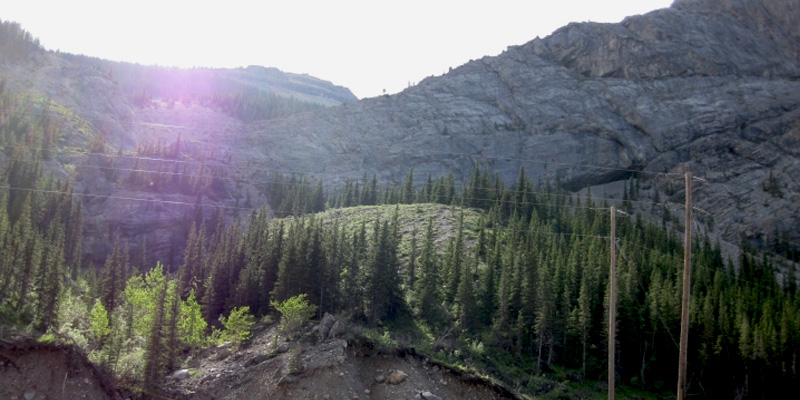
Cadomin Caves
The Cadomin Caves is a multi-chamber cave system that stretches 2,791 m (9,150 ft) in length. It is located in Whitehorse Wildlands Provincial Park, about 75 minutes from the small town of Edson. While exploration and caving is allowed, the cave remains wild and proper equipment and experience is necessary. The caves are a bat habitat and are thus closed from September to April.
Orge Canyon
Come see the towering cliffs, meandering streams and sunken sinkholes of this impressive canyon, located west of Hinton near Brule.
Icefields Parkway
Between Jasper and Lake Louise, visitors can explore a series of ice-age old glaciers that form the Icefields Parkway. It is possible to drink in the views of the six massive glittering white glaciers at Columbia Icefield and then quaff from its pure water run-off. These colossal rivers are slowly retreating and the subsequent meltwaters feed into three different oceans, a distinction the Icefields share with only one other spot in the world. A succession of rivers, lakes, and foothills extend east toward David Thompson Country—a region named after the great Canadian explorer and geographer who mapped the area in the late 1700s. Farther east are two towns with historical significance. Nordegg was once the home of an important coal mine and Rocky Mountain House was an integral fur trading post. The region has remained largely unchanged, making it a popular destination for hiking and backcountry camping. Outside of the national park, regulated fishing and hunting also attract many to the area as the unspoiled nature of the region has allowed local wildlife to thrive.
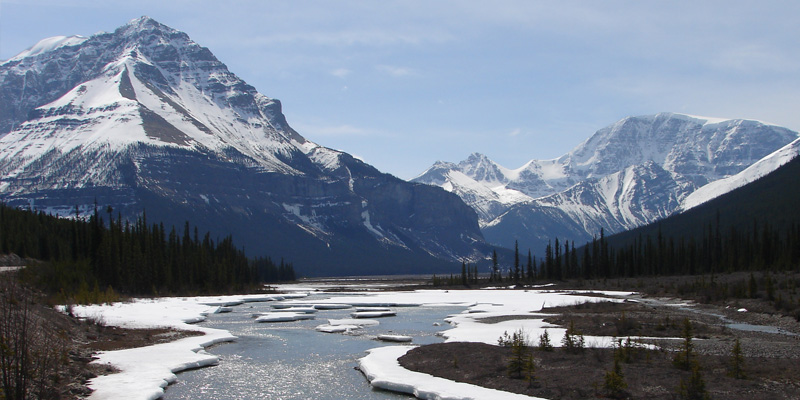
Rocky Mountain House Museum
Visitors to the Rocky Mountain House Museum can peruse various pioneer artifacts and displays, and check out a forestry cabin and a 1920’s schoolhouse.
David Thompson Resort
The David Thompson Resort is a full-service family resort with hotel rooms, cabins and camping accommodations, all surrounded by stunning mountain scenery.
Jasper, Alberta
Mountains are Jasper’s calling card. Deep in the Alberta Rockies, peaks crown the horizon in every direction. The vast majority are pristine and will remain that way, preserved under the aegis of Canada’s national parks system. Mountain sheep, bears, wolves, elk and mountain goats have a secure home here, and can often be seen when simply driving down the road. To improve the chance of spotting a Grizzly bear, adventure seekers can opt for a hiking tour or explore the surrounding wilderness on horseback. But even from inside the car, the mountain views are spectacular. In particular, the road south of Jasper to Lake Louise is renowned for its breathtaking vistas. About halfway down, motorists often stop at the Columbia Icefield to view a still mighty but receding glacier, part of the Icefields Parkway and Eastern Slopes region. In the town of Jasper itself, visitors enjoy a peaceful small-town atmosphere, while chalets, B&Bs; and famous Fairmont Jasper Park Lodge offer a wide range of accommodations, often in buildings reflecting a distinct alpine architecture. For information about visitor destinations near Jasper, read about Edmonton, Hinton, Lake Louise and Valemount, BC.
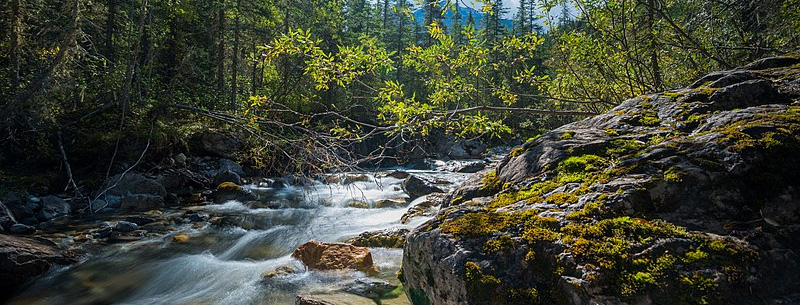
Jasper Hot Springs
Visitors won’t soon forget a drive up the wild Fiddle Valley to Miette Hot Springs, the hottest mineral springs in the Rockies. Flowing from the mountain at 54ºC, the water is cooled to a comfortable 40ºC as it enters the pools. Two hot pools and two cool pools within a newly renovated facility. Peaceful surroundings with a café, a gift shop, hiking, a picnic ground, interpretive exhibits and plenty of camping and accommodation nearby. Suits, towels and lockers for rent. Open May to mid-October. Located between Jasper and Hinton. Address: Miette Road | Jasper, AB. Telephone: 1 780 866-3939
Kananaskis Country
K-Country, Alberta. Spectacular mountain scenery and rugged terrain, coupled with a convenient location make Kananaskis an enchanting destination for travelers from around the globe. Situated only an hour’s drive west of Calgary, Kananaskis, also known as K-Country to Albertans, promises exciting outdoor adventure opportunities every season of the year, including mountain biking, hiking, horseback riding, and white water rafting. Nakiska Ski Hill, the site of the 1988 Winter Olympic skiing competitions, offers world-class downhill facilities, including 6 lifts and 28 marked runs. Nearby Kananaskis Golf Course offers 36 challenging holes and has been rated among the top courses in Canada for its unparalleled scenery, outstanding facilities and exceptional service. Kananaskis Village offers a series of luxury accommodations and fine restaurants, but those who don’t mind roughing it can catch some z’s at one of the many campgrounds. Be careful though—the region is known for having an abundance of wildlife, including bears and cougars.
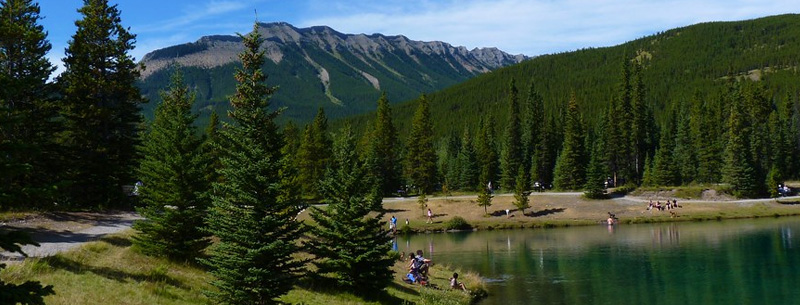
Highwood Pass
The Highwood Pass takes Highway 40 from the alpine evergreens of Kananaskis Country to the foothills and flatlands to the southeast. The pass is located just south of Kananaskis Lake and is the highest paved road across the Continental Divide at 2,206 m (7,233 ft).
Nakiska
Site of ’88 Olympic Winter Games alpine events. Long groomed cruising runs, extensive snowmaking, spacious day lodge, 2 high-speed quads.
Lake Louise
The turquoise waters of Lake Louise, in Alberta’s Rockies, have been photographed so often now, the lake has become something of a cliche for mountain serenity. And yet, nothing quite prepares the visitor for the unearthly beauty of this alpine gem. The lake owes its color to fine particles suspended in the glacier waters, but few visitors at the world-famous Fairmount Chateau Lake Louise are thinking of hydrology as they look out over the waters from the luxury hotel. Downslope from the Chateau, the town of Lake Louise has its own charm. Small but well-appointed with restaurants, accommodation, and stores, the townsite is an ideal getaway destination in summer when trail riding, hiking, rafting, and mountain biking predominate. Wildlife is also a major draw with elk commonly sighted from the road and even the occasional bear. In winter, Lake Louise Ski Hill is the major attraction with its world-class ski runs.

Valemount
Valemount sits 120km (74.6mi) from Jasper and is a charming alpine village situated on the western slopes of the Canadian Rockies near Mount Robson Provincial Park. Visitors can explore the Valemount and Area Museum and Archives, which gives insight into the life and times of the area—s settlers and contains a restored 1914 Canadian National Railway station. See Chinook salmon spawn at the George Hicks Regional Park, and view wildlife such as waterfowl, moose and beavers, either unaccompanied or with trained guides at the Robert W. Starratt Wildlife Sanctuary. Experience the local geography by walking one of the many interpretive trails at the Valemount Jackman Flats Nature Reserve and end the day with a meal at one of the town—s dining establishments. Visitors can choose from restaurants that serve Korean, Chinese, Japanese and more traditional Canadian fare. Golfing, fishing, rafting, hiking, and snowmobiling are just a few of the unlimited adventures that allow outdoor enthusiasts to enjoy the natural setting and spectacular scenery of Valemount.
Valemount and Area Museum and Archives
Relive pioneer days with a renovated 1914 Canadian National Railway station, fully outfitted caboose, and trapper’s cabin display. Patrons may look through photographs, enjoy exhibits and view artifacts. Hours of operation vary depending on the season, check with the museum. Address: 1090 Main St., across the tracks. | Valemount, BC. Telephone: 1 250 566-4177
Waterton
Waterton Lakes National Park is an unspoiled gem tucked away in the southern corner of Alberta along the Canada-U.S.A. border. The Canadian side of the park actually combines with Montana’s Glacier National Park, creating an international peace park. The park is rife with an assortment of natural attractions. Some of the park’s most visited sites include Cameron Falls and Red Rock Canyon, with both serving as compelling backdrops for wildlife viewing, day hikes and more. Hiking is a favorite pastime of those who frequent the Waterton area, and the Crypt Lake Trail continues to impress hikers of all skill levels. Waterton townsite is located in the heart of Waterton Lakes National Park and boasts easy access to all of the park’s attractions—along with providing restaurants, local gift shops, and lodgings.
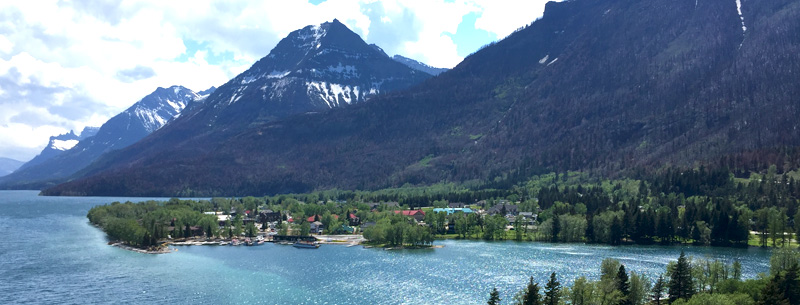
Waterton Lakes National Park
Established in 1895, the park joined with Montana’s Glacier National Park in 1931 to form the first International Peace Park. It is one of the most untouched areas in the province, ranging from prairie terrain to mountain wilderness. Visitors can enjoy hiking, fishing, horseback riding, golf, and interpretive programs, or visit the Waterton-Glacier International Peace Park World Heritage Site.
